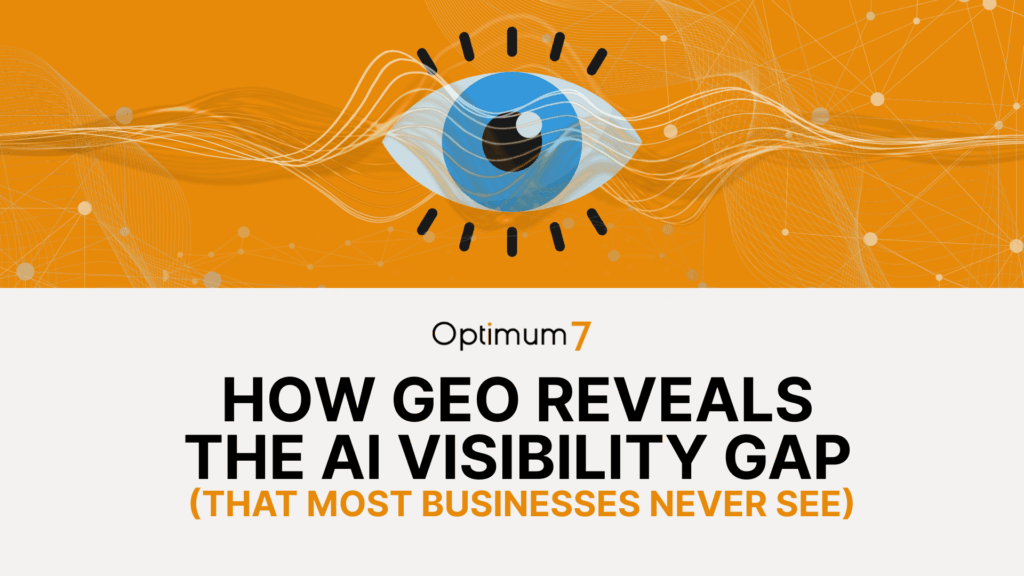Why Visibility in AI Engines Matters More Than Rankings
There was a time when ranking on Google felt like the pinnacle of digital marketing success. If your site sat on page one, you won. If your blog captured a featured snippet, you celebrated. And if your competitors didn’t show up until page two, well—game over for them.
That time is over.
Today, the real decision-making happens long before a buyer hits your homepage. It happens inside AI engines like ChatGPT, Claude, Perplexity, and Deepskeep—tools that your future customers are already using to research solutions, compare providers, and validate their decisions. And here’s the scary part: they’re doing it silently, without triggering a single analytics alert or form submission on your site.
We’ve entered an era where summarization beats search, and where answers replace results.
If your brand isn’t showing up in those AI-generated responses—if you’re not being cited, mentioned, or even hinted at—you don’t just lose visibility. You lose relevance. And in 2025, that means you’re not even in the running.
AI Engines Don’t Just Link—They Decide
When someone types a query like, “What’s the best cybersecurity software for healthcare in 2025?” into Google, they get a list of links to parse. They can skim, compare, bounce, or dig deeper at their own pace.
But when they ask that same question to ChatGPT or Claude, something different happens: they get a curated, confident answer. One that reads like a trusted advisor is speaking directly to them. The engine doesn’t suggest. It summarizes. It doesn’t ask them to decide. It decides for them.
That answer might include a few brands. It might list three providers with short explanations. It might include sources, or it might not. But here’s what matters—if your brand isn’t part of that answer, you never even had a shot.
And most marketers don’t realize this is happening until it’s too late.
We’ve spoken with companies who were shocked to discover their competitors were showing up in AI-powered summaries, while they were totally absent—even though they were outperforming those competitors in SEO, PPC, and paid social. The engine didn’t care. It simply responded based on what it had learned to trust.
The Silent Filter: When Buyers Never Even See You
It’s one thing to lose a deal because a competitor beat you in a demo. It’s another to lose the deal before the buyer even knows your brand exists.
That’s what’s happening now, especially in high-ticket B2B categories. Buyers—especially technical decision-makers, procurement leads, and enterprise buyers—are no longer visiting five vendor websites and reading all your content. They’re asking ChatGPT. They’re testing Claude’s answers. They’re opening Perplexity to scan summaries pulled from trusted domains.
And if you’re not showing up there?
You don’t get compared.
You don’t get clicked.
You don’t even get disqualified—you get ignored.
This is the new marketing battlefield: presence inside the answer layer. And if you don’t have visibility there, all your funnels, retargeting campaigns, and ABM plays are running uphill.
AI Is the New First Touch
Forget top-of-funnel. The AI engine is the funnel now.
Buyers ask, “Who are the top logistics software providers that integrate with SAP?” They get an answer in 8 seconds. They see three names. Maybe they recognize one. Maybe they click one. The rest? Invisible.
There’s no second page. There’s no option to scroll. There’s just what the model says—and that’s what they trust.
So when we talk about visibility, we’re not just talking about attention. We’re talking about being seen by the machine that’s mediating trust before the buyer ever gets to you.
That’s why this article matters.
Because if you don’t know whether these engines are talking about you—or worse, you assume they are—you’re flying blind in the most important layer of digital marketing today.
You need to be tracking this. Auditing it. Testing for it. And most of all, acting on it.
Because in this new game, you don’t get points for being visible on Google.
You get pipeline for showing up inside the answer.
What Is an Answer Visibility Report?
Too many brands still think of visibility in terms of old-school metrics: impressions, clicks, page-one rankings. But in 2025, that’s not the full picture. Because now, your buyer could run an entire research process without ever seeing your site, your ad, or your blog. They’re not browsing—they’re asking. And the answers they get don’t come from search engines. They come from AI.
That’s where the concept of Answer Visibility enters the chat.
Answer Visibility is the new benchmark for brand presence in an LLM-dominated internet. It tells you whether large language models like ChatGPT, Claude, Perplexity, and Deepskeep are mentioning your brand when real people ask real buying questions.
And make no mistake—this is happening. People are already typing into Claude:
- “Best B2B CRM alternatives to Salesforce”
- “Top logistics software providers with SAP integrations”
- “Most trusted cybersecurity vendors for healthcare”
They’re doing this on their phones, during meetings, on deadline. They’re not analyzing ten tabs—they’re trusting the answer. If your brand doesn’t appear in that context, it might as well not exist.
An Answer Visibility Report is how you find out whether you’re in the conversation—or just watching from the sidelines.
Keyword Visibility vs. Answer Visibility
Traditional keyword visibility tells you where you rank in search results when someone types in a specific query. It’s useful, but it only reflects one slice of behavior—human-driven, browser-based, multi-tab search journeys.
Answer visibility, on the other hand, tracks whether your brand is included, cited, or even mentioned in AI-generated responses to the kinds of high-intent prompts real buyers are using.
Here’s the difference in plain terms:
- Keyword visibility says: “Your page is ranking #5 for ‘SaaS ERP for manufacturing.’”
- Answer visibility says: “When someone asks ChatGPT ‘What are the top ERP solutions for mid-market manufacturers in 2025?’—your brand is cited once every 20 responses, usually as an afterthought.”
One tells you how searchable you are.
The other tells you how trusted you are by the new decision-makers—AI engines that filter, interpret, and compress the internet into a single stream of perceived expertise.
The Core Outputs: Frequency, Context, and Source
A real answer visibility report doesn’t just count mentions. It breaks them down in ways that matter:
- Frequency: How often does your brand show up in response to relevant prompts? Is it once every hundred? Once every ten? Or not at all?
- Context: Are you mentioned as a leader, as an alternative, or buried at the bottom of a long list? Are you shown in competitive comparisons or only when someone asks directly for your name?
- Source: Is the mention coming from your site? A third-party review? A high-trust publication like TechCrunch or Wired? Or is it hallucinated with no real basis at all?
These distinctions matter. Because just getting named isn’t enough. You want to be referenced consistently, with authority, from sources that reinforce your positioning—not dilute it.
A good visibility report will also show you how different engines behave. You might be dominant in Perplexity but invisible in ChatGPT. You might have strong branded answers but weak comparative ones. Each model has its own citation logic, and your strategy needs to adapt accordingly.
Being Referenced > Being Ranked
In the AI ecosystem, ranking is an outdated metric. These engines aren’t presenting you on a list. They’re pulling you into a story. And whether you get included depends on how credible, consistent, and structured your presence is across the internet.
Being referenced means you’ve made it into the model’s mental map. It means when someone asks a question in your category, the engine considers your brand worth talking about. That’s a different kind of win—and it’s one you can’t fake.
You can rank with technical tricks.
But you can only get referenced with trust, structure, and repetition.
That’s what an Answer Visibility Report reveals.
Not just whether you’re ranking—but whether you matter.
The Challenges of Tracking AI Mentions Across Engines
You’re Not Invisible—You’re Just Blind
The first reaction most teams have when they realize AI engines are controlling buyer perception is: “Okay, where can I see this in analytics?” And the brutal truth is—you can’t.
There’s no dashboard. No search console. No report that tells you how many times Claude mentioned your brand this week or whether Perplexity is linking to your whitepaper. These engines are black boxes. They weren’t built to give you insights—they were built to give users answers.
That makes traditional marketing attribution tools completely useless in this context. You can’t UTM tag an LLM. You can’t pixel a ChatGPT session. You can’t “crawl” your brand presence across Claude responses.
And so, most brands assume there’s nothing they can do. They give up on measuring what might be the most important new layer of visibility since the first Google crawler launched in 1996.
But just because the platforms don’t provide visibility doesn’t mean you can’t measure it.
It just means you have to reverse-engineer it yourself.
That’s where answer visibility reporting comes in—but before we get into how, let’s get real about the three major challenges you’re up against.
No Index. No Logs. No Consistency.
Unlike Google, these AI engines don’t index pages in the traditional sense. There’s no sitemap to submit. No crawl budget to manage. They’re either trained on your content—or they’re not. And if they’re connected to real-time web access, like Perplexity, their retrieval logic is still opaque.
You’re not just dealing with a lack of indexing. You’re dealing with a lack of accountability.
If your brand doesn’t show up in a ChatGPT answer, is it because:
- The model was never trained on your content?
- Your site structure made you hard to parse?
- You haven’t been cited by third parties enough?
- Or the prompt simply didn’t trigger your relevance?
There’s no way to know from the outside. And these models don’t come with visibility logs or referrer data to help you guess. Every answer is generated in real time, and most disappear the moment the user refreshes the screen.
That volatility makes manual tracking nearly impossible.
Memory, Hallucination, and the Danger of False Positives
Another complication? AI engines don’t just pull from hard-coded data. They synthesize. They blend. They paraphrase. That means your brand might show up in one answer as a named recommendation, and in another as a vague “company offering similar services.” Or worse—not at all.
Even more dangerous? Hallucination. Sometimes, LLMs fabricate references entirely. They’ll cite an article that doesn’t exist, link to a page that’s not real, or reference a quote you never gave. To the user, it sounds legit. To you, it’s a branding nightmare.
This makes AI mention tracking even harder. You can’t just search for your brand name. You have to analyze the language around it. You have to determine whether it’s a hallucination or a real reference. And that means building your own quality control pipeline into the visibility audit process.
It’s not just about “are we mentioned.” It’s about how, why, and from where.
Manual Prompt Testing Doesn’t Scale
Some teams try to hack this by running prompts manually. Open up ChatGPT, type in a query, see what comes up. Repeat with Claude. Do it again tomorrow. Track results in a spreadsheet.
That sounds fine—until you realize you’d need to run hundreds of prompts across four engines, across multiple categories, across several versions of each model, to get even a partial picture.
Then do that weekly. Or daily. Or every time you publish something new.
Manual testing might give you anecdotal feedback, but it doesn’t give you data. It doesn’t give you insight. And it certainly doesn’t give you an edge when your competitors are investing in automated systems that run thousands of prompts, parse outputs with NLP, and feed back into real-time strategy.
You wouldn’t track SEO without a crawler or analytics.
So why would you try to track AI visibility with guesswork?
This is the heart of the problem: LLMs control perception, but offer no reporting.
That gap is exactly what answer visibility reports were built to fill.
Step-by-Step: How Optimum7 Runs Visibility Reports (Framework)
Running an AI visibility report isn’t just about playing with prompts and hoping your brand shows up. It’s a repeatable, structured process that simulates real-world buyer behavior across multiple AI engines—and then breaks down those results into insights you can act on. This is where Optimum7 operates differently.
We’re not guessing. We’re testing at scale. And we’re doing it the way your buyers behave: through intent-based questions, across the tools they actually use, with zero assumptions about how the engine “should” behave.
Let’s walk through exactly how we do it.
Setting Up Prompt-Based Queries by Buyer Intent
The entire process starts with understanding how your ideal customer would actually ask their question. No one is typing “ERP software + compliance” into Claude. They’re typing fully-formed queries like:
“What’s the best cloud-based ERP platform for a mid-sized healthcare company that needs HIPAA compliance?”
Or:
“Who are Salesforce’s main competitors for enterprise CRM in 2025?”
These are natural language prompts rooted in real buyer psychology. They include context. Industry. Use case. Sometimes even emotional cues like urgency or frustration. And that context dramatically changes which brands show up.
So instead of dumping in keywords, we map out prompt clusters based on:
- Branded queries (“Is a good choice for X?”)
- Category discovery queries (“Top X software for Y”)
- Direct comparisons (“ vs ”)
- Problem-first questions (“How do logistics companies manage inventory across warehouses?”)
Each of these prompt types reveals something different about your AI visibility. And taken together, they give us a full 360° view of how the engines perceive your brand.
Using LLM APIs to Run Structured Tests at Scale
Once the prompts are set, we don’t just run them manually. We plug them into a system that leverages the APIs for ChatGPT, Claude, Perplexity, and Deepskeep—engines that all operate differently under the hood.
This is where things get technical. But here’s the high-level idea:
- ChatGPT tends to synthesize based on memory and training data. Unless the Web Browsing plugin is used, it won’t cite sources. It “remembers” brands that were part of its training up to a certain date and favors familiarity over freshness.
- Claude, on the other hand, often favors content from trusted domains and structured citations. It pulls in more explicit references and tends to name specific players—especially in B2B tech and SaaS categories.
- Perplexity is the most transparent. It always cites sources, gives you links, and allows us to analyze which domains it relies on most frequently. It’s a goldmine for visibility tracking.
- Deepskeep is the newcomer but extremely relevant in technical B2B verticals. It’s tuned to recognize subject-matter authority, structured content, and emerging expert entities. Think of it as entity-first rather than keyword-first.
We run each prompt through each engine, store the results, and track how your brand shows up—or doesn’t.
No copy-pasting. No screenshots. This is structured data gathering from real AI output.
Parsing Outputs for Brand Mentions and Citations
Once we have the data, it’s time to separate signal from noise.
Mentions can take a lot of forms. Some engines cite your brand explicitly: “Company X is one of the top vendors.” Others bury it in a sentence: “Solutions like Company X and Company Y…” Some don’t use your brand name at all, but paraphrase your positioning.
We use NLP parsing tools and human QA to flag:
- Direct mentions
- Indirect references
- Citations tied to URLs
- Hallucinated or incorrect references
Structured citations (like Perplexity linking to your Capterra profile) carry a different weight than vague mentions or hallucinated inclusions. We tag and label each one to understand how credible your visibility is—not just how frequent.
Because it’s not enough to be mentioned. You need to be cited, trusted, and accurately represented.
Measuring Frequency, Placement Type, and Source Domain
Next, we score and benchmark each result across three dimensions:
- Frequency – How often are you mentioned across engines and prompts?
- Placement Type – Are you listed in the top part of the answer, buried at the bottom, or used as an example in passing?
- Source Domain – If cited, where is the engine pulling that citation from? Your site? A third-party review? A high-trust publication?
A mention in the first sentence of Claude’s answer from TechRepublic carries more weight than a throwaway name at the end of a ChatGPT response hallucinated from thin air.
We normalize across engines, because behavior varies. ChatGPT might be more conservative. Perplexity might flood the zone with sources. Claude may cite three high-trust names and ignore everything else. That’s why our visibility scoring system accounts for engine bias—so you’re not measuring apples against oranges.
What you get, in the end, is a detailed view of your brand’s position in the minds of machines.
And in 2025, that might be the most important visibility report you ever read.
Building the Brand Answer Visibility Index (BAIV)
You Can’t Improve What You Can’t Measure
One of the most frustrating realities about AI visibility is that even once you understand how it works, you still have no clean way to measure your performance—until now.
At Optimum7, we needed a better scoreboard. A way to track how often brands were being cited across engines, and more importantly, to understand why those citations were happening. Frequency alone wasn’t enough. You could show up five times and still be irrelevant if those mentions came from the wrong place, in the wrong context, at the wrong depth.
That’s why we built the Brand Answer Visibility Index, or BAIV for short.
It’s not a vanity metric. It’s not another dashboard gimmick. It’s a purpose-built scoring system that reflects how present and trusted your brand is across real buyer questions inside AI engines. Think of it as the domain authority of 2025—but tuned for decision-making machines, not search engine crawlers.
The Anatomy of BAIV: What the Score Actually Reflects
Let’s break it down. The BAIV score is the result of three key variables working together:
- Prompt Cluster Coverage
How often does your brand appear across a wide range of buyer-driven questions? Not just “best software,” but “alternatives to ,” “solutions that integrate with ,” and problem-first prompts like “how do companies solve ?”
- Engine Diversity
Do you only show up on one engine, like Perplexity, or are you visible across ChatGPT, Claude, Deepskeep, and others? A healthy brand should appear consistently across multiple models, since each engine is used by a different type of buyer persona or analyst.
- Citation Trust and Context
Are you being mentioned as a top pick or a footnote? Are you cited by respected third-party sources or hallucinated by the model? Is the reference positioned with authority, or buried in a list of “other options”?
We weight each of these elements, score every query across every engine, and roll it all up into a single, trackable number. A number that actually means something. Because if your BAIV score is low, it’s not guesswork—it’s proof that you’re being left out of the conversation.
And the best part? We don’t just give you a score and walk away. We tell you why your score is what it is—and how to change it.
From Raw Data to a Living Visibility Map
This isn’t a static spreadsheet. The full BAIV output is a living visibility matrix. You’ll see color-coded prompts across buyer stages, engine by engine, with citations noted, sources linked, and context included.
The best way to think about it? It’s a heatmap of where your brand exists in the minds of AI engines—and where you’re still invisible.
You’ll notice some prompts that light up like a Christmas tree—because you’ve published the right content, earned the right citations, and structured it all perfectly. But others will be cold. Missing. Or worse, dominated by a competitor you’ve been outranking on Google for years.
That’s when things get real. That’s when you realize: they’ve been training the model, and you haven’t.
And once you can see it? You can fix it.
Because BAIV doesn’t just tell you how visible you are. It shows you exactly where the gaps are, what to publish, where to land media, and how to structure it so that Claude, ChatGPT, Perplexity, and Deepskeep actually take you seriously.
In this new world, your AI footprint is your first impression.
BAIV makes sure it’s not your last.
Common Visibility Patterns and What They Reveal
AI Mentions Aren’t Random—They Tell a Story
Once we started running visibility reports across hundreds of prompts and AI engines, something fascinating emerged: clear, consistent patterns in how brands show up—or don’t. These weren’t just anomalies. They were repeatable behaviors tied to how a brand positions itself, how it’s covered by others, and how well it’s structured for machine understanding.
In other words, AI citations are signals. And like any signal, they reveal what the model thinks about you—even if you’ve never directly interacted with it.
Let’s walk through a few of the most common patterns we see, and what they actually mean.
The Third-Party Dependent Brand
This one is surprisingly common. A company doesn’t mention itself well online—its content is weak, vague, or buried in marketing jargon—but it’s been covered by a few high-authority media outlets or review platforms. So when Claude or Perplexity responds to a buyer query, it pulls the mention straight from those sources.
You might think, “Hey, great—we’re getting cited.” But here’s the problem: you’re not in control of the narrative. The model is lifting someone else’s framing of your value prop. It might be outdated. It might be shallow. It might not even mention your most important features or use cases.
We’ve seen brands who were consistently showing up in AI answers—but only because of a single listicle published two years ago. That kind of dependency is dangerous. It means one broken link or de-indexed page could erase you from the answer layer overnight.
If this is your brand, you don’t need more press—you need structured reinforcement. You need your own site, your own content, and your own narrative formatted in a way the engine can parse and trust directly.
The Inconsistent Presence Brand
This is where things get weird. One engine loves you, the other acts like you don’t exist.
Let’s say you show up consistently in Claude responses, but ChatGPT never mentions you. Or you dominate in Perplexity queries, but Deepskeep leaves you out of every technical comparison.
This inconsistency tells us two things. First, you’ve probably built strength in a single content environment—maybe you’ve been picked up in publications that Claude is trained to recognize, or your site structure is perfectly aligned for Perplexity’s citation engine.
But second—and more importantly—it shows a gap in your cross-model relevance. And in 2025, that’s a visibility risk.
Different buyers use different engines. If you’re only showing up on one, you’re missing a massive slice of your audience. Worse, the models aren’t reinforcing each other. They’re not “learning” that you’re a dominant voice across contexts. And that lack of repetition weakens your perceived authority.
The fix isn’t to flood every engine with content. It’s to standardize your structure, amplify your earned media across multiple sources, and make sure your message travels consistently. That’s how you turn a lopsided presence into true visibility resilience.
The Category Leader That Disappears in Comparisons
Here’s the most ironic pattern of all: the brand that wins on category terms but loses when buyers ask comparative questions.
Maybe you rank highly for “best B2B invoicing software” in ChatGPT. Great. But then someone asks, “What’s the difference between and ?” and suddenly… nothing. You’re not cited. Or worse, only the competitor is.
This usually happens when your content strategy is too “safe.” You talk about your product in general terms but avoid direct competitive positioning. You shy away from naming rivals, drawing lines in the sand, or publishing structured comparison pages. And because of that, the models never learn how to reference you in contrast.
This matters because comparative prompts are high-intent. They signal that the buyer is close to making a decision. If you’re not visible there, you’re losing deals after they’ve already heard of you.
The solution isn’t aggressive takedowns or puffed-up battle cards. It’s clarity. Publish structured comparisons. Show real differences. Get those pages cited by trusted analysts or review sites. Train the models to include you not just as a category option—but as a choice worth defending.
Because if the engine can’t explain why you’re better, it will choose someone else who can.
Deep Dive on Each Engine’s Behavior
One of the biggest mistakes we see from even the most seasoned B2B marketers is treating all AI engines like they’re interchangeable. They’re not.
Each large language model has its own personality. Its own memory, preferences, and biases. Some cite meticulously, others don’t cite at all. Some prefer structured, enterprise-style content; others draw more from public forums and community data. And some just flat-out hallucinate.
If you’re not tailoring your visibility strategy to the specific quirks of each engine, you’re leaving opportunities—and citations—on the table.
Let’s walk through how each of the big four behaves in the wild.
ChatGPT: The Memory-Lover with a Soft Spot for Familiarity
When it comes to ChatGPT, you’re dealing with a model trained on a snapshot of the internet. Unless someone’s using the web browsing plugin, it’s not pulling in real-time data. It’s relying on what it learned before its knowledge cutoff—or what it’s retrieved through fine-tuned plugins.
What does this mean for visibility?
It means recency isn’t your friend. Recognition is. ChatGPT tends to cite brands it’s seen over and over again during training. Think well-known vendors, dominant voices in high-authority publications, companies with a long content trail of structured, repeated messaging.
We’ve run tests where a newer, rapidly-growing SaaS company got completely ignored—while a legacy competitor with outdated features still showed up prominently. Not because it was better. Just because it had more time to get embedded into the model’s worldview.
If your brand is relatively new or hasn’t invested in structured authority content, ChatGPT will probably pretend you don’t exist. And it won’t be personal. It’s just math. You didn’t make the cut during training.
But if you have earned media citations that go back years, or you’ve built a dense content ecosystem around specific buyer problems, you’re more likely to show up. Especially in summary-style answers that ask for a list or category breakdown.
Still, ChatGPT has a downside—it rarely cites its sources. So even when you get mentioned, it’s tough to trace where that mention came from. That makes optimization tricky unless you test prompts often and build pattern recognition into your reporting.
Claude: The Structured Thinker That Loves a Trustworthy Source
Claude is the quiet workhorse of the LLM world. It doesn’t get as much buzz as ChatGPT, but in many cases, it delivers better, more thoughtful answers—especially for complex B2B and enterprise topics.
Why? Because Claude leans heavily on structure and authority.
It tends to pull from documents with clean formatting, consistent terminology, and a clear author or source. Think expert blog posts, whitepapers, analyst roundups, or press coverage from credible sites. If your content is a wall of unstructured marketing fluff, Claude skips it. But if it sees clean subheaders, cited data, and topic consistency across your digital footprint? You’re in.
We’ve seen brands that struggle to get visibility on ChatGPT start winning immediately on Claude—simply because their content was better organized and easier for the model to digest.
What’s more, Claude tends to favor real-time grounding. If your content is being published and picked up across sources that it regularly accesses, your chances of showing up increase dramatically. This is where having a strong earned media strategy becomes more than PR—it becomes a technical distribution channel.
The bottom line? If you’re structured, cited, and consistent, Claude will reward you. But if your content is a mess, you’ll be invisible—no matter how big your brand is.
Perplexity: The Transparent One That Keeps Receipts
Perplexity is the easiest of the four to understand—and arguably the most honest.
When it gives you an answer, it shows you where that answer came from. You get links. Sources. Context. That transparency makes it invaluable for visibility tracking because you’re not guessing—you’re seeing exactly how the engine perceives you.
The flip side? You can’t fake your way in.
Perplexity heavily favors real-time web content, so if your site is slow, unstructured, or buried under design-heavy templates, your visibility will suffer. This engine indexes the open web quickly, but it prioritizes sites with schema, clean markup, and content that answers questions directly.
This is one of the reasons Perplexity has become such a critical tool for B2B research. Buyers use it to pull up expert-backed lists, vendor comparisons, and practical how-tos—and they rely on the citations to vet credibility. If your competitor is getting linked from G2, TechRepublic, and BuiltIn, and you’re stuck with one outdated blog post from 2022? Good luck.
What we love about Perplexity is that it rewards tactical, thoughtful content. If you’re publishing detailed guides, comparisons, or integrations—and formatting them for easy scanning—you’ll be cited. If you’re not, you’ll be ignored.
Simple as that.
Deepskeep: The Entity-Obsessed Newcomer with a Taste for Experts
Deepskeep might be the least known of the four, but it’s punching way above its weight—especially in technical and niche B2B sectors.
Unlike the others, Deepskeep doesn’t just care about keywords or even citations. It’s focused on entities. That means companies, people, products, tools, and relationships between them. It’s tuned to treat your brand as an object in a web of meaning—not just a string of characters.
This gives it a unique strength: precision.
Deepskeep thrives on highly structured, technically accurate content. Schema is its love language. FAQs, product specs, integration documentation, API walkthroughs—these aren’t just helpful, they’re essential. If your content isn’t structured to surface entities, Deepskeep won’t “see” you at all.
But if it is? You’ll show up in side-by-side comparisons, vendor network maps, and technical solution breakdowns that no other engine currently offers.
Deepskeep is also less prone to hallucination than ChatGPT, but it’s more narrow in scope. That means your visibility depends heavily on domain-specific authority. If you’re trying to compete in a niche where you’ve never published deep technical content, you won’t show up—even if you dominate on Google.
The takeaway here is simple: Deepskeep is a goldmine for brands that sell complex solutions to smart buyers. But only if you treat your content like it’s training an AI, not marketing to a casual browser.
How to Improve Your Visibility Based on the Report
A visibility report isn’t a trophy. It’s a mirror. It shows you where your brand is being seen, where it’s being ignored, and why AI engines are choosing someone else to represent your category in the answers that matter.
Once you’ve seen the truth, the only question that matters is: what are you going to do about it?
At this point, most brands make one of two mistakes. The first is doing nothing—telling themselves, “Well, we’ll work on that later,” and slipping further into obscurity while competitors train the models week after week. The second is trying to brute-force visibility with a flurry of blog posts or keyword-stuffed landing pages, hoping volume will fix trust.
Both approaches fail. Because LLMs don’t care how much content you publish. They care whether they can understand it, verify it, and trust it enough to include you in an answer.
Here’s how we fix that—starting with the most underrated weapon in the entire AI visibility arsenal.
Land the Mentions That Actually Move the Needle
This might be hard to hear, but it’s the reality in 2025: your content doesn’t matter if it’s not being cited by others.
LLMs, especially Claude and Perplexity, weigh third-party mentions far more heavily than self-declared authority. It’s not enough to write a great guide or a compelling comparison page—you need someone else, ideally someone already trusted by the models, to say your name.
This is where earned media becomes strategic, not decorative.
At Optimum7, we start by reverse-engineering which domains are getting cited most often by the engines. We look at the links inside answers. We identify the publication patterns. And we build a targeted media map—a short list of high-value placements that will have real, measurable impact on your visibility.
You don’t need 50 mentions. You need five good ones—on the right sites, in the right context, with the right structure.
If you can land a feature in a publication that Claude references regularly, or get listed in a roundup Perplexity pulls from repeatedly, that one move can boost your BAIV score faster than six months of SEO sprints.
This isn’t PR fluff. It’s AI strategy.
And it starts by being intentional about where your brand shows up—and how.
Restructure Your Content So Machines Can Digest It
Once you’ve shored up your earned media presence, it’s time to take a long, honest look at your own content. Not through the lens of a human reader, but from the eyes of a machine trying to decide: Should I cite this?
Most brand sites—especially in B2B—fail this test.
Their content is locked in bloated design systems. Headers are inconsistent. Pages are long but directionless. There’s no clear hierarchy, no semantically relevant markers, and no structured relationships between pages. To a human, it might be fine. To a model like Deepskeep or Claude, it’s borderline unreadable.
Fixing this doesn’t mean stripping down your design or killing your brand voice. It means clarifying your structure. That starts with your H1s and H2s, your internal linking strategy, and your use of consistent terminology across similar pages.
It also means creating content designed to answer, not just rank. You need pages that speak directly to high-intent prompts—the same ones that surfaced in your visibility report. If your buyers are asking, “What’s the best HIPAA-compliant CRM for legal firms?” and your site doesn’t answer that question in those terms, the models won’t see you. Full stop.
This is where we often rebuild pages entirely—not because the ideas were bad, but because the structure wasn’t built for machines.
When your content becomes machine-legible, you go from invisible to inevitable.
Reinforce Your Position with Schema That Speaks Their Language
Even after you’ve published great content and landed the right citations, there’s one more step to truly cement your position inside the answer layer—and that’s schema.
Schema markup is the closest thing to a direct line of communication with AI engines. It’s not just an SEO tool. It’s a visibility protocol.
When you use schema to label your FAQs, your product comparisons, your reviews, and your authorship, you’re giving LLMs a shortcut to trust. You’re telling them, “This is a legitimate piece of information. Here’s what it’s about. Here’s who wrote it. Here’s how it relates to other content on this site.”
Most brands still treat schema as a technical detail—something they maybe added once, a few years ago, and haven’t touched since. But in this new visibility war, schema is leverage.
You can use it to declare your content’s structure, define your named entities, and create relationships between pages that the model will recognize and follow. You’re not hoping the engine understands your expertise. You’re showing it, in its own language.
We’ve seen visibility reports shift within weeks of fixing schema—because suddenly, the model has everything it needs to cite you with confidence.
You don’t need to rewrite your site to win. But you do need to make sure the parts that matter are built like they belong in the answers.
From Visibility to Action: Tracking ROI After Citations
Let’s be clear—getting your brand cited in an AI-generated answer isn’t the final goal. It’s the starting point. Visibility only matters if it turns into pipeline. You don’t get paid in mentions. You get paid in meetings, proposals, and signed deals.
And yet, this is where most brands stop short. They treat AI visibility as a branding metric—something to feel good about, not something to plug into actual revenue operations.
That’s a missed opportunity. Because with the right tracking infrastructure, you can move from “Hey, we’re being mentioned!” to “That mention drove $130K in enterprise pipeline last quarter.”
Yes, it’s possible. No, it’s not easy.
But the brands that figure this out will dominate attribution in the age of answer engines.
Start with UTM Strategy Built for AI-Discovered Traffic
The moment your content starts showing up in Perplexity answers or Claude-generated summaries with linked citations, you’ve got a new kind of inbound: AI-assisted intent.
These are people who didn’t Google you. They didn’t click an ad. They got your name from an answer, got curious, and followed the rabbit hole straight to your site.
So how do you track that?
First, you make sure the pages being cited are tagged properly. UTM overlays on core URLs, proper canonical tags, and smart segmentation in your analytics tool. If your answer visibility report shows that your G2 profile or industry feature on BuiltIn is frequently pulled into Claude summaries, make sure any links back to your site from those pages include campaign tagging.
Even better—build “answer landing pages” with unique URL structures, so if a user hits that page first, you know exactly how they got there.
This isn’t traditional campaign tracking. You’re not looking for traffic spikes from newsletters or social drops. You’re looking for downstream echoes of visibility—and you need your UTM architecture to listen.
Watch for Surges That Don’t Fit the Old Patterns
Here’s where things get interesting.
Once you start showing up in answers, your traffic might not explode overnight. Instead, you’ll see strange, subtle surges: a bump in direct traffic on Mondays, more branded queries in GA4, or a lift in demo requests that don’t map to your outbound efforts.
This is what we call “prompt-lag impact.”
It’s not direct response. It’s second-order behavior. A buyer sees your brand in an AI answer on Monday, thinks about it, maybe talks to a colleague, then hits your site on Thursday after Googling your name. No ad, no email, no campaign. Just memory—powered by machine recommendation.
The key is to look for patterns in places you normally wouldn’t.
Has your inbound lead quality improved in the last 60 days?
Are you getting more demo requests where the prospect already knows your differentiators?
Are sales calls starting with, “I saw your name in a few tools…”?
That’s AI-driven awareness. You won’t find it in attribution software. You’ll find it in behavior.
And if you’re paying attention, you can link it back to specific prompts and content that started the chain reaction.
Connect the Dots: From Answer to Opportunity
The final piece is building a closed-loop map from visibility to lead flow.
This doesn’t mean overbuilding. It means being intentional about three things:
- Making your highest-cited content lead to conversion points
- Training your SDRs to ask, “Where did you hear about us?” with AI engines included in the options
- Segmenting leads by AI visibility tier—so you can see which ones came from high-exposure prompts
Over time, this creates a feedback loop. You’ll start to see that the prompts where you show up most frequently—especially those with high buyer intent—drive the best opportunities. Not just more leads, but better-fit deals, shorter cycles, and less friction.
That’s when visibility turns into revenue.
Not because you guessed. Not because you hoped.
But because you measured, mapped, and acted.
You don’t need perfect attribution. You just need to close the loop far enough to know where to double down.
30-Day Optimization Sprint Based on Report Findings
Don’t Wait Six Months. Visibility Can Shift in 30 Days.
Most marketing leaders treat visibility like it’s some long, slow-moving play—something that takes quarters to measure and even longer to fix. That used to be true when SEO was the only game in town.
But in the world of AI-generated answers, perception moves faster than rankings ever did.
Why? Because models like Claude, Perplexity, and Deepskeep ingest, respond, and adapt at the speed of new data. If you fix the right issues, and reinforce them across structured content and earned media, you can shift your AI footprint in weeks.
That’s why we built a 30-day optimization sprint. It’s not a magic bullet—but it is the most focused, high-leverage way to go from invisible to included in the answers that drive deal flow.
Here’s how we run it.
Week 1: Clean Your Foundation and Run Your Baseline
You can’t optimize what you haven’t measured. So the first thing we do is run a full-scale Answer Visibility Report—one that maps where you’re showing up, where you’re not, and which prompts are driving brand mentions across engines.
Once that baseline is captured, we turn inward and clean house.
This means tightening your content structure—fixing broken markup, aligning headers, removing visual fluff that confuses machines, and bringing schema into every page that matters.
No new content yet. No new campaigns. Just signal clarity. Because if your existing assets aren’t readable, the best strategy in the world won’t get you cited.
Think of it as resetting your presence so the engines know how to recognize you going forward.
Week 2: Targeted Earned Media for Maximum Impact
Once your structure is solid, it’s time to hit the gas on placement strategy. But not the old-school kind.
We use the visibility report to reverse-engineer which sites are already getting cited by the engines. Then we target those domains—editorially, contextually, and surgically.
No spray-and-pray PR. No wasted pitches. We’re only aiming for placements that will move the BAIV score. That might mean securing a byline in a niche SaaS blog that Claude loves, or getting listed in a comparison roundup on a mid-tier tech site that Perplexity trusts deeply.
When done right, even a single strategic mention can elevate your position in dozens of prompts.
This isn’t awareness. It’s engine conditioning.
And week two is where the model starts to notice you.
Week 3: Publish Machine-Readable Assets That Actually Answer the Prompts
Now that you’re cited externally and structured internally, it’s time to feed the models new, optimized content.
But not just anything.
We build and publish assets specifically designed to match the exact prompts where you were absent in the baseline audit. That might be a comparison page, a use-case-specific landing page, or a rewritten FAQ page loaded with schema and clean semantic structure.
Everything gets tuned for readability—not just for humans, but for models.
No fluff. No jargon. Every page is written to be answer material. So that when someone types “Best data security solutions for mid-market banks” into ChatGPT, your new page fits the bill—clean, relevant, and worthy of being cited.
This is where the engines don’t just see you—they start to trust you.
Week 4: Re-Run the Audit and Measure the Delta
The final week is all about truth.
We rerun the entire visibility audit—same prompts, same engines, same scoring. But now, the landscape has changed. Your structure is fixed. You’ve landed earned mentions. You’ve published net-new machine-friendly content that speaks the engine’s language.
And what you see next? That’s your delta.
Sometimes it’s subtle—a bump in mentions on Perplexity, a few new appearances in Claude summaries. Other times, it’s a surge. Prompt clusters that were ice cold start lighting up. Competitor-heavy answers now include your brand, and sometimes even lead with it.
We track those changes against lead flow, demo requests, and site behavior to start closing the attribution loop.
In one month, you went from invisible to visible. From passive observer to active signal.
That’s not theory. That’s how AI visibility actually works—when you stop guessing and start operating with precision.
Tools and Templates to Build Your Own Reporting Stack
Let’s be real: most B2B teams don’t have the time—or internal firepower—to build a full AI visibility system from zero. The engineering lift, the testing infrastructure, the prompt design, the output parsing… it’s not something you spin up in a Google Sheet.
But that doesn’t mean you have to wait for some overpriced platform to show up and do it for you. The truth is, with the right building blocks, you can create a lightweight, functional reporting stack that gives you visibility into how AI engines treat your brand—without needing a full-time data team.
That’s why we started packaging the exact tools and templates we use at Optimum7 to run these audits at scale.
We didn’t invent this for fun. We did it because our clients needed proof—not just gut feelings—about where they stood inside the LLM landscape. So now we’ve taken the internal playbook and made it usable, flexible, and fast for any in-house team that’s ready to own their AI footprint.
Here’s what’s in the toolbox.
Prompt Cluster Templates: Know What to Ask, and How
The first piece of the stack is deceptively simple: asking the right questions. But if you’ve ever tried testing prompts across ChatGPT or Claude, you already know how fast that becomes a mess.
Our prompt templates are built by vertical—B2B SaaS, logistics, FinTech, cybersecurity, supply chain, you name it—and cover four categories of intent: branded queries, competitive comparisons, pain-first problems, and category discovery.
You’re not just testing for your name. You’re testing for your relevance across the real questions buyers ask before they ever land on your site.
These prompt sets aren’t generic. They’re engineered from actual sales conversations and used across multiple clients to uncover high-value prompt clusters that drive answer visibility. You plug in your category and brand details, and you’re ready to run the test.
It’s like running paid search campaigns—but instead of ads, you’re injecting your brand into AI-driven decisions.
Python Parsing Scripts: From Raw Text to Structured Insight
Once you’ve run 100+ prompts across four engines, you’re not going to “read” them all manually. You need a way to parse, clean, and tag outputs automatically—especially when engines don’t always format their responses the same way.
That’s where the Python scripts come in.
We built lightweight scripts that scrape your prompt responses, flag direct and indirect mentions, identify the context of each citation, and categorize them based on how authoritative they are.
Are you mentioned in the first sentence? Do you show up as a top pick, or just an “also-ran”? Is the source legitimate, or did the model hallucinate you into existence?
The parser handles all of that. You end up with a clean, filterable dataset you can use to calculate your BAIV, compare against competitors, or track progress over time.
Even if you’re not technical, someone on your team—or a friendly freelancer—can run it and hand you back structured insights.
Visual Dashboards: Turn Data into Decisions
The final piece of the stack is where it all comes together: the visibility dashboard.
You don’t need another boring spreadsheet. You need a living map of your brand’s AI presence—something that shows, at a glance, which prompts you dominate, which ones you’re missing, and which engines are helping or hurting you.
We build these in tools like Airtable and Looker Studio, depending on what stack you already use. They’re color-coded, filterable, and built to show BAIV trends over time. Want to know how your Perplexity visibility changed after that TechCrunch placement? It’s in there. Curious if Claude picked up your new pricing page? You’ll see it.
And because everything is tagged by prompt, engine, and source type, you’re not just seeing data. You’re seeing action items. You know what to double down on. You know what to fix. You know what’s working.
This is the kind of visibility that actually changes strategy.
Because when the data finally speaks your language, you start making decisions that stick.
Final Thoughts: Visibility Is the New Domain Authority
You’re Not Just Competing for Traffic Anymore—You’re Competing for Narrative
There was a time when getting backlinks and optimizing title tags felt like the most strategic thing a B2B marketer could do. And it worked—Google rewarded effort. Authority was earned through content, technical polish, and patience.
But that version of the internet is sunsetting. Quietly, steadily, answer engines have replaced search engines in the early stages of buying behavior. And now, it’s not about who ranks. It’s about who gets remembered.
This is a war for attention inside the minds of machines.
And domain authority doesn’t matter if ChatGPT doesn’t bring up your name.
This isn’t hype. It’s happening right now. Buyers are building shortlists based on AI answers. Analysts are feeding prompts into Claude before vendor interviews. Founders are scanning Perplexity for the “best option” on a Sunday afternoon—and trusting the summary more than your homepage.
If your brand isn’t visible there, it’s not just a missed opportunity. It’s a missed future.
Because these engines don’t just reflect reputation.
They create it.
Becoming the Brand AI Engines Can’t Ignore
So, how do you become one of the few—one of the brands that shows up first, gets cited often, and starts to feel like a default answer inside your category?
You build signal.
You create structure.
You win citations that the engines already trust.
You stop shouting and start engineering. Your website becomes an instruction manual for LLMs. Your PR becomes a map of which voices shape AI answers. Your content becomes training material—not for your buyer, but for the model deciding whether your buyer even sees you.
This is what it looks like when visibility becomes a strategy.
And not just SEO visibility.
Answer visibility. AI visibility. Strategic presence inside the tools that now mediate trust.
Once you see the game, you can never unsee it.
You’re either in the answer…
Or you’re out of the conversation.
Get Your Brand’s AI Visibility Audit
Let’s get you in the answer.
We’ve built the first visibility audit designed specifically for ChatGPT, Claude, Perplexity, and Deepskeep. This isn’t some generic SEO report. This is a forensic scan of where your brand lives—or doesn’t—inside the tools your buyers already trust.
Here’s what you’ll walk away with:
- A benchmark visibility score across top prompts and LLMs
- A full breakdown of your citations, context, and source domains
- A 30-day execution playbook to boost BAIV and engineer citations
- Real examples of how your competitors are shaping the narrative—and how to take it back
You’ll finally have clarity. Not just on whether you’re visible—but on how to become unmissable.
This is the new competitive edge.
And it’s yours—if you’re willing to look.


















